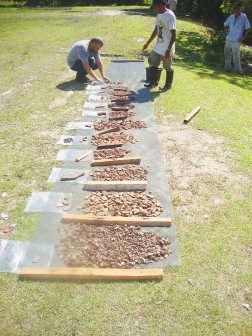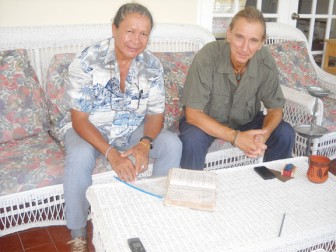Guyanese archaeologist George Simon and a team of scientists are on the verge of making key discoveries on human settlements which may have existed in the Berbice area as long as 5000 years ago.
The team has been working in the Berbice River community of Dubulay and will this weekend hold a public forum at the Umana Yana to unveil their findings. The team of 12 had been working at Dubulay for a three-week period on the project which is called the Berbice Archaeology Project.
During an interview with this newspaper yesterday, Simon and University of Wisconsin professor of anthropology, Neil Whitehead stated that the findings at Dubulay will significantly add to Guyana’s rich history.

Simon stated that the work in the area surrounds the archaeological excavation of a mound site at Dubulay and the team is also conducting a related exploration of raised fields in the savannahs in the middle of the Berbice River.
The Dubulay project, Simon noted, required the testing of soils taken from the site. He said that the mound is referred to as the Terra Preta mound since it consisted of the Terra Preta soil type. The soil is particularly characteristic of dense long-term human settlement.
Simon stated that the area at Dubulay, which is located close to the ranch in the area, had been exposed to human habitation for years beyond 5000 (Before Present) and he said that the team has found that there has been continuous occupation of that area.
He said that in 1992 Whitehead accompanied him to the sites and a test trench of a mound revealed an age of approximately 2000 years before the present day.
Initial observation
The project had its origins in the observation of Major-General (ret.) Joe Singh who noticed on one of his many flights to the GDF Battle School at Takama, that the surrounding savannahs were covered with small mounds.

Earlier, in 1987 Simon, who was then attached to the Walter Roth Museum, was dispatched to investigate and at the same time also first identified the presence of Terra Preta soils.
Other professional pursuits meant that it was not until 2009 that expert archaeologists from the University of Florida – Michael Heckenberger, with wide experience of anthropological research in Amazonia, and David Steadman, an expert in neo-tropical zoology – were available to assess these sites. Test pits on the middle Berbice revealed dates for human occupation going back 5,000 years and this preliminary work was the basis for applying for funding from the National Science Foundation (NSF) based in Washington, D.C. to return in 2011 at the invitation of the University of Guyana to expand these initial insights.
More recently, Simon noted, the team visited the area and further investigated its base and according to him, throughout the excavation “we have been finding pottery which indicates that it has been occupied by people”.
He said that the team was not sure of the type of people, noting that “It’s very speculative” but he said that the area was common to the Arawak people. He said that Heckenberger who has been investigating similar projects in the Amazon area, even postulated that the persons who occupied the area may have had connections to Bolivia, “and he wants to think it’s the same people who were there”.
Whitehead stated that the main aim of the study is to complete the tests, which will be undertaken in the United States using advanced equipment, to determine what people might have lived there along with the time period. He stated that the findings were significant for archaeology particularly in this part of the world.
The Tests
The tests have techniques, Simon explained, but he noted that they are simple and he explained that it required the sinking of a hole in the ground with a shovel to about three feet, then sifting the sand or other material.
The team would then look for pottery which would give an indication that people lived there. The pottery pieces which would be displayed on Saturday at the function at the Umana Yana are both plain and decorative, while Whitehead noted that the find includes a few European pieces of ware which indicates that there were some places where there was contact between the Amerindians and Europeans.
As regards the derivation of the time period of 5000, Simon noted that this was determined via a simple process. “It’s basically taking samples of carbon and samples of carbon charcoal, and burning it and the gases from it will give an indication of the time period. In 2009 we did that to get that BP date but the fragments which we collected more recently will now give us a new debate for the site”.
He said that he hopes that the time dates back to as much as 10,000 BP, adding that “it puts Guyana right back on the map, for me as an archaeologist, it’s contrasting with another date and having historical meanings”.
The findings are expected to be analysed within the next few weeks and Whitehead stated that such should be completed by the end of September.
Project benefits
Simon stated too that the findings could be beneficial for the agriculture sector as it would give an indication of the value of the land in terms of its production capacity. He said too that the findings would be good for research and future studies.
The duo noted that one bugbear in the project was funding but the American National Science Foundation decided to pump money into the project via grants after viewing the initial findings in 2009.
“It’s very unique and big for Guyana and it changes the way we think …it also indicates, the type of agriculture used and further to that Guyana now has a key role to play.”
The Ministry of Culture, Youth and Sport has been supporting the project.




